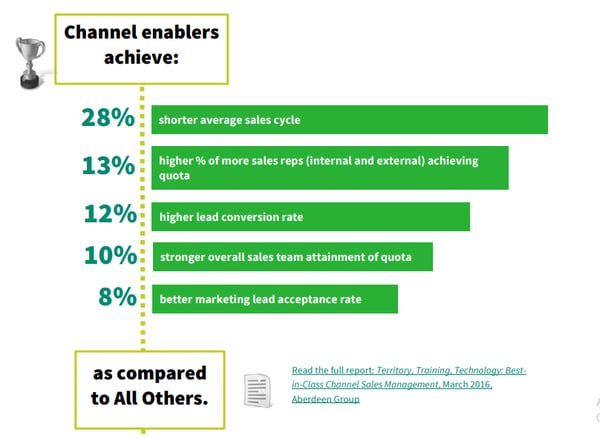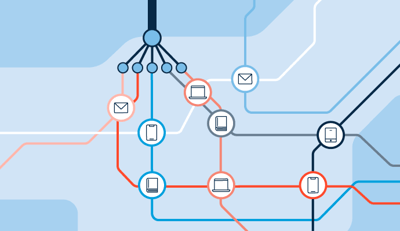December 17, 2020
 by Mehdi Hussen / December 17, 2020
by Mehdi Hussen / December 17, 2020

Traditionally, sales couldn’t be scaled unless you hired more salespeople or marketers, and supported their processes and overheads.
This is now rapidly changing as there are more ways than ever to distribute information, and buyers are getting savvier.
Today there are several platforms where your target audience spends time online. Having a presence on these platforms can help drive attention and awareness regarding your product and services.
Platforms like these have brought better opportunities for organizations in scaling their sales beyond selling and marketing their products themselves. There are several new “channels” to sell through.
In this article, we will learn what channel sales is and how it works favoring the consistent growth of your business.
The channel sales model works on the principle of having third-parties selling your product and services to their respective audience. This is facilitated through partnerships with these third parties that have an audience relevant to your product.
Entities like affiliate partners, product vendors, value-added resellers, strategic partners, agents, distributors, and system integrators have traditionally been the channels of choice. But in the past few years, online channels have taken over traditional ones in generating leads in volumes. Having contextual placements for your product on a third party’s content or assets could help you drive traffic, and eventually, close leads.
Product comparison platforms like G2, or marketplaces such as Shopify or the Google Chrome Web store, are some examples of these channels that could help you sell to audiences on respective platforms.
Channel sales is the practice of selling your products to leads generated from third-party sources (i.e. channels) – like marketplaces, affiliates, and resellers. It is a way to distribute your products outside of your own marketing channels.
Channel sales helps you expand your reach beyond your own audience and keep generating a healthy volume of leads for your business.
As we discussed, the channel sales model is one where you work with a third party to sell for you. Direct sales are the opposite, where all the sales are driven entirely by you, all leads being generated from your own channels and team. With channel sales — you are essentially appointing distributors for your product, where your product’s introduced to a third party’s audience. In return, they get a minority share of the sales they bring, which could be relatively less than what you spend while selling directly.
This impacts your sales process in a few ways as follows.
When it comes to generating more leads, channel sales are more efficient than direct sales. Scaling your own channels to generate more leads, or conducting outbound sales takes time and effort. With Channel sales, you are tapping into an existing pool of fresh leads, hence not needing any extra efforts from your side. Expanding into new markets and targeting a different demographic with a new product is much easier while selling through channels.
Also, since channel sales bring leads from a third party, the time needed to close them is shorter vs. direct sales leads. Channel sales lead on average are known to have a 28% shorter sales cycle. Leads from third party channels are likely to be high intent and pre-nurtured, converting touchless. In direct sales, leads will need to be nurtured once they have been introduced in the sales funnel and will have to go through a longer sales cycle.

Selling via a third party this way enables you to untie your sales revenue from your in-house sales efforts, which helps you get your product to as many customers as possible, quickly. This works great for products that are converting and retaining customers at above-average rates – which is a signal for product-market fit. Once you've achieved a product-market fit, channel sales could be the driving force behind achieving your next big revenue milestone.
Now that we have come to understand how channel sales work, let us dive deeper and understand how to put a channel sales process in place.
Before you get into assigning a third-party channel to sell for you, it is important to first assess if your product is ready for that channel. If you are a younger company needing to find their first few customers, it might not be the right time to assign channel partners, since you might have not realized who your real (and potential) customers are.
If your product has a great following, great reviews from existing customers, a very well defined target audience, you can then go ahead and find third party channels where you will find these potential customers.
Once you know you are ready to sell via third-party channels, you need to then go around working on the specifics.
You’ll need to start working on a list of potential partners, size revenue pipelines from each of these channels, set up incentive structures (where you control them), etc. Each of these things has to be intentional based on your organizational and revenue goals from channel sales. Incentive structures, in particular, need to be set up based on existing product margins and potential payouts to channel partners, so channel conversions remain profitable.
Before the final step of reaching out and assigning partners, you would need to set up a few internal processes to work with third-party leads. This could include a dedicated sales funnel, billing setup, onboarding flow, etc to make sure you are ready to close third-party leads when they start coming in. Set up landing pages, educational videos, pre-recorded demonstrations, and more to nurture new leads from respective channels and help convert them without sales assistance.
With internal processes in place, you can now set up these channels to start generating leads. This would include the logistics around partner outreach and channel setup. The first step would be to sign up, or reach out to these partners.
Setting up a channel, for example, with a marketplace, or a review website would require producing content as per the platform’s guidelines (screenshots, videos, descriptions). Also, make sure there are tracking mechanisms in place to help you measure conversions from a channel. If there are specific UTM parameters you want to set for the channel, you can communicate the same to your partners.
Apart from the benefits, we have already mentioned, here is why we think channel sales is beneficial.
Channel sales generate touchless conversions since they are pre-nurtured, compared to direct sales leads. Acquisition costs are much lesser depending on the channel. Channel conversions don't add any overheads to your sales team, which makes it a great way to scale your sales efficiently. It saves you the time and money that would have otherwise been invested in acquiring a bigger audience to sell directly to.
As a consequence of touchless conversions, you get to convert more leads per sales cycle, and without the overheads, you are effectively growing your revenues passively. This enables you to set your focus towards building a better product and providing superior customer service instead of hiring more salespeople.
Leads driven from third-party channels are often well researched, informed, and tend to trust your services more since you’re being referred through existing customers or users. Quality leads spend less time in your pipeline and have higher conversions (12% more) and LTV as a result. This drives up conversions and retention in the long term.
Although it might sound like the perfect way to grow — selling through third-party channels doesn’t go without having its own drawbacks.
Since you are generating leads from a third-party, they will need to be incentivized for the same. A lot of platforms and marketplaces take a share of sales, which will eat into your margins and net profits. Depending on the volume of leads generated and your existing margins, commissions and fees towards third-party channels can start eating into your profits if not kept in control.
Partnering with another platform for generating leads would mean that even though they trickle down passively, it’s often beyond your control, in case you would want to scale or grow it faster.
Third-party channels might have large, but finite and skewed audiences that could react unpredictably. For certain channels to break even in terms of profitability, consistent volumes of leads might be needed, since commissions and fees reduce your effective margin per conversion. Declining traffic and volumes in such conditions might force you into selling unprofitably.
In continuation from the last point, since you are not able to control the traffic from a third-party platform, the same holds true with respect to low-intent leads. You might often generate leads who’re only to use your services for the offer period, or only sign up out of curiosity.
For example, being ranked well on a marketplace would mean you would attract both people from your target audience and outside of it. This could include bad actors, who might use your product for use cases outside the ones it’s intended for. Apart from vulnerability to platform and security risks, you might see declining NPS scores and LTVs from customers who don’t use your product as intended over the long term.
Let's explore a few avenues you can use to find channel sales partners.
You can find individuals who are experts and have authority over your niche, and have them promote your products. For big-ticket sales, “rainmakers” — people who might be able to make an introduction and ease a sale can be involved to help you find and close new deals in exchange for commissions.
For smaller ticket products, you can get the help of publications and blogs that cater specifically to your target audience. You can have your products featured across their pages contextually and drive traffic to your website. This can be done either by purchasing direct advertising spots or having the publications as an affiliate, so they can drive traffic and leads on your behalf.
Find what products your existing and potential customers use apart from yours. You can partner up with these companies and co-promote each other’s products and services to respective audiences. If your products are integrated well with such channel partners, it also drives up your retention and LTV metrics as a result which leads to more product usage.
Product review platforms and device platforms can host your product in their marketplaces. These marketplaces and platforms are home to your potential customers, and getting listed or featured on these platforms can help you drive traffic back to your website. Take SuperLemon as an example. Their Shopify app generates 5,000 leads a month and has a conversion rate of 7.5% as mentioned by the founder in an interview.
Here are 11 metrics you can track to measure and track the success of your channel sales efforts.
Channel metrics are indicators of a channel’s performance, helping you evaluate and invest in the right channels. Here are the metrics you can use to measure a channel’s performance:
Conversion metrics of your channel sales efforts help you measure the rate of closure out of the leads being generated. You can track the below metrics to keep a check on your channel sales conversions:
Bottom line, or bottom of the funnel metrics are used to measure the performance of channel sales operations based on the amount of profits generated. These ultimately help measure the combined bottom-line impact of channel sales and keep a track of channel quality and trends.
Channel sales can be a great boost to your sales growth if done right - given you have a delightful product and find the right partners. This not only helps you expand your reach and find new customers but also offers your customers a great experience by helping them make quick purchase decisions and augmenting their current set of tools and services.
The benefits of channel sales are not just limited to scaling your sales revenues. Channel sales can greatly augment your existing pipelines with more leads, ensuring you have more leads to nurture and close. If there comes a time when your direct marketing traffic takes a hit, third-party channels can help you make up for it by redirecting their audiences.
With the right set of tools, tracking, and processes in place and bad actors kept at bay, you can make channel sales a key driver towards your company’s growth and sustainability.
Mehdi Hussen is the Head of Marketing at Zoomshift, an employee schedule software. He is passionate about driving organic growth and customer acquisition for startups through data-driven content marketing. He spends his spare time musing about startup growth strategies, personal productivity, and remote work.
Multi-channel marketing allows you to engage with your audience where they are, all at once.
 by Sagar Joshi
by Sagar Joshi
Consumer demand for personalized experiences is at an all-time high.
 by Keerthi Rangan
by Keerthi Rangan
Consistency is the key to everything.
.jpg) by Aayushi Sanghavi
by Aayushi Sanghavi
Multi-channel marketing allows you to engage with your audience where they are, all at once.
 by Sagar Joshi
by Sagar Joshi
Consumer demand for personalized experiences is at an all-time high.
 by Keerthi Rangan
by Keerthi Rangan


